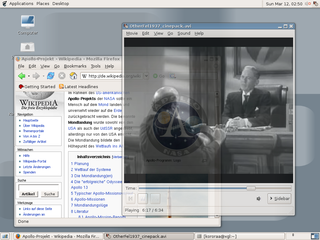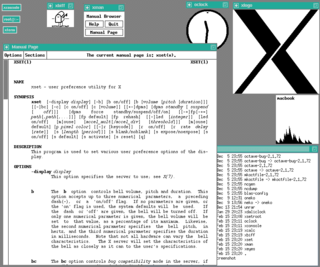
An X window manager is a window manager which runs on top of the X Window System, a windowing system mainly used on Unix-like systems.

In computer science, multiple buffering is the use of more than one buffer to hold a block of data, so that a "reader" will see a complete version of the data, rather than a partially updated version of the data being created by a "writer". It also is used to avoid the need to use dual-ported RAM (DPRAM) when the readers and writers are different devices.
GLX is an extension to the X Window System core protocol providing an interface between OpenGL and the X Window System as well as extensions to OpenGL itself. It enables programs wishing to use OpenGL to do so within a window provided by the X Window System. GLX distinguishes two "states": indirect state and direct state.
The X video extension, often abbreviated as XVideo or Xv, is a video output mechanism for the X Window System. The protocol was designed by David Carver; the specification for version 2 of the protocol was written in July 1991. It is mainly used today to resize video content in the video controller hardware in order to enlarge a given video or to watch it in full screen mode. Without XVideo, X would have to do this scaling on the main CPU. That requires a considerable amount of processing power, which could slow down or degrade the video stream; video controllers are specifically designed for this kind of computation, so can do it much more cheaply. Similarly, the X video extension can have the video controller perform color space conversions, and change the contrast, brightness, and hue of a displayed video stream.

Xinerama is an extension to the X Window System that enables X applications and window managers to use two or more physical displays as one large virtual display.

The Direct Rendering Infrastructure (DRI) is a framework for allowing direct access to graphics hardware under the X Window System in a safe, efficient way. The main use of DRI is to provide hardware acceleration for the Mesa implementation of OpenGL. DRI has also been adapted to provide OpenGL acceleration on a framebuffer console without a display server running.
In computing, the X Window System is a network-transparent windowing system for bitmap displays. This article details the protocols and technical structure of X11.

In the X Window System, an X display manager is a graphical login manager which starts a session on an X server from the same or another computer.

GDK is a library that acts as a wrapper around the low-level functions provided by the underlying windowing and graphics systems. GDK lies between the display server and the GTK+ library, handling basic rendering such as drawing primitives, raster graphics (bitmaps), cursors, fonts, as well as window events and drag-and-drop functionality.

Xgl is an obsolete display server implementation supporting the X Window System protocol designed to take advantage of modern graphics cards via their OpenGL drivers, layered on top of OpenGL. It supports hardware acceleration of all X, OpenGL and XVideo applications and graphical effects by a compositing window manager such as Compiz or Beryl. The project was started by David Reveman of Novell and first released on January 2, 2006. It was removed from the X.org server in favor of AIGLX on June 12, 2008.
In computing, hardware overlay, a type of video overlay, provides a method of rendering an image to a display screen with a dedicated memory buffer inside computer video hardware. The technique aims to improve the display of a fast-moving video image — such as a computer game, a DVD, or the signal from a TV card. Most video cards manufactured since about 1998 and most media players support hardware overlay.

The X Rendering Extension is an extension to the X11 core protocol to implement image compositing in the X server, to allow an efficient display of transparent images.

In computing, a tiling window manager is a window manager with an organization of the screen into mutually non-overlapping frames, as opposed to the more popular approach of coordinate-based stacking of overlapping objects (windows) that tries to fully emulate the desktop metaphor.
Desktop Window Manager is the window manager in Windows Vista, Windows 7, Windows 8 and Windows 10 that enables the use of hardware acceleration to render the graphical user interface of Windows.

Accelerated Indirect GLX ("AIGLX") is an open source project founded by Red Hat and the Fedora community, led by Kristian Høgsberg, to allow accelerated indirect GLX rendering capabilities to the X.Org Server and DRI drivers. This allows remote X clients to get fully hardware accelerated rendering over the GLX protocol; coincidentally, this development was required for OpenGL compositing window managers to function with hardware acceleration.

GNU Emacs is the most popular and most ported Emacs text editor. It was created by GNU Project founder Richard Stallman. In common with other varieties of Emacs, GNU Emacs is extensible using a Turing complete programming language. GNU Emacs has been called "the most powerful text editor available today". With proper support from the underlying system, GNU Emacs is able to display files in multiple character sets, and has been able to simultaneously display most human languages since at least 1999. Throughout its history, GNU Emacs has been a central component of the GNU project, and a flagship of the free software movement. GNU Emacs is sometimes abbreviated as GNUMACS, especially to differentiate it from other EMACS variants. The tag line for GNU Emacs is "the extensible self-documenting text editor".

Wayland is a computer protocol that specifies the communication between a display server and its clients, as well as a reference implementation of the protocol in the C programming language. A display server using the Wayland protocol is called a Wayland compositor.

A display server or window server is a program whose primary task is to coordinate the input and output of its clients to and from the rest of the operating system, the hardware, and each other. The display server communicates with its clients over the display server protocol, a communications protocol, which can be network-transparent or simply network-capable.












